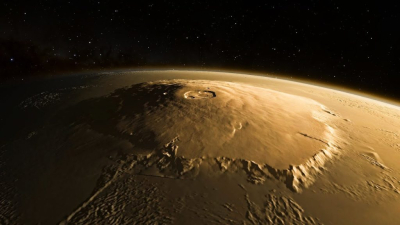
Volcanism is the eruption of molten rock or magma onto the surface of a planet. This activity is crucial in changing the topography of the concerned planet. Planet Earth has volcanoes on all the continents. But which is the largest volcano in the solar system?
Olympus Mons
Towering high, some three times as high as Mt. Everest (8.8 km) is a huge volcano on planet Mars. Christened "Olympus Mons", the volcano is the largest in the solar system!
It sits on the edge of a huge plateau called the Tharsis Bulge. It was formed as a result of the continuous flow of lava over millions of years. It is said to have begun some 115 million years ago.
Olympus Mons is one among a dozen large volcanoes in the Tharsis Montes region. Most of these volcanoes are ten to hundred times larger than their terrestrial counterparts. Olympus Mons is the tallest of them and towers 16 miles (25 km) above the surrounding area.
So how big is Olympus Mons?
Let's take the case of Hawaii's Mauna Loa, the largest volcano on Earth. The volume of Olympus Mons is 100 times larger than Mauna Loa. It is said that the whole of the Hawaiian islands will fit inside the Olympus Mons. It spreads across 374 miles, the size of the state of Arizona.
A shield volcano
A shield volcano is called so because of its shape. Instead of the lava getting violently thrown out, here the molten material would be flowing down the sides of the volcano slowly.
As such it would appear like a warrior's shield seen from the side and hence the name. Shield volcanoes are wider when compared to their height. The outer edge of Olympus Mons is surrounded by a cliff that reaches a height of about 6 miles. This cliff itself is as tall as Mauna Loa. The base of the volcano is surrounded by a wide depression.
According to studies, Olympus Mons is a relatively young one though it took the volcano over a hundred million years to form, there are regions on the mountain that are just a few million years old. The volcano is considered to be active even now with the potential to erupt.
But why did such a giant volcano form on the red planet and not on Earth, one may ask? According to scientists, the low surface gravity of the planet and the rate of eruption led to the lava piling up higher on Mars. In the case of Earth, the movement of the crust prevents the build-up of lava.
Picture Credit : Google




